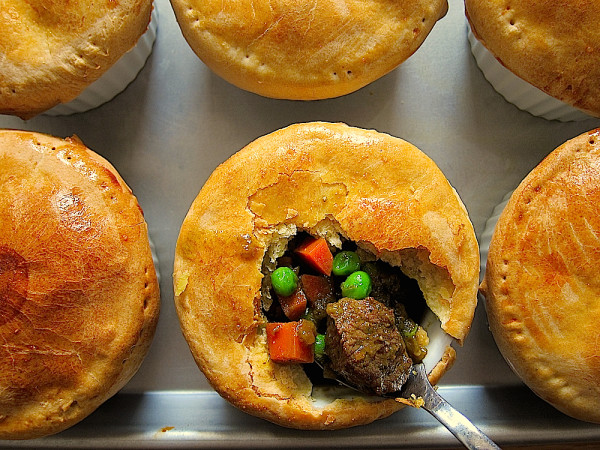Inspired by the British mince pie and classic American pot pie, this version could only come from deepest, darkest, Peru — made with Seco de Cordero spicy lamb stew filling, and a warm and flaky Empanada crust, ladies and gentlemen, I present to you, the Peruvian Pot Pie.
During my last trip to London, I visited Borough Market and learned about the mince pie and its history and was very surprised that the crust of the first meat pies was not edible, but rather a hard mixture of water and flour that served only to preserve and transport the meat filling. Not edible? The crust? To me, one of the best parts of a pie (or an empanada!) is the crust, so I am grateful to the French pastry chefs that added butter and fat to the dough, finally making it into the edible delicacy we know today.
My favorite way to test a new recipe is to share it with friends, and recently I had the pleasure of preparing this Peruvian Pot Pie for dinner, and was delighted at how surprised my guests were. Served as if it were a small gift in a tasting menu, they wondered, “what’s in the pie?” — and breaking the crust with a spoon would reveal one of the most traditional Peruvian dishes, hiding in a pot pie that could only be made with the dough for an empanada. A few minutes later, looking at all the empty ramekins, I smiled and was pretty sure that I was onto something. I absolutely loved combining two of my favorite things: baking empanadas and slow cooked stews, and next time, I’ll have to make some more.
PREPARATION
In addition to the ingredients for the lamb stew and empanadas, you’ll need a pot to cook the lamb, assorted baking utensils to mix, shape, and roll the dough, and 8 small 4 oz. ramekins.
- Cook the Seco de Cordero lamb stew with 2 modifications: omit the potato, and dice the carrot into smaller pieces.
- Prepare the dough for Empanadas, and cut into 8 circles, about 4 1/2 inches each.
- Prepare the glaze for Empanadas.
- Scoop the lamb stew into the ramekins.
- Cover each ramekin with the dough circles, moisten the bottom edge of the dough with water and press the dough against the edge of the ramekin.
- Use a fork to press the dough against the edge of the ramekin, making lines that radiate away from the center of the ramekin.
- Prick the top of the dough with a fork.
- Using a brush, coat the dough with some glaze.
- Arrange the ramekins on a baking sheet, and place in the oven for 30 minutes or until the crust is a golden color.
- Remove from oven and serve warm.
SERVINGS
8 servings.
